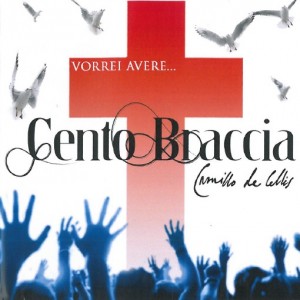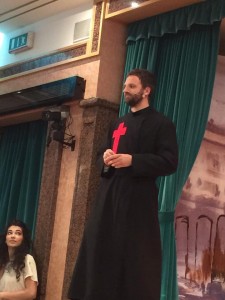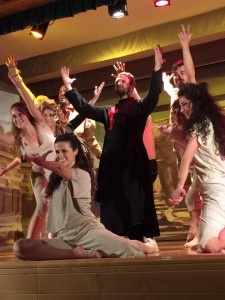Giovanni Papini wrote that ‘to heal the sick, medicines are not enough, you need love, that is to say the high temperature of the soul. Fever against fever, spirit against flesh. That is what St. Camillus did’.
 Put together on a Roman evening at the beginning of summer an elderly saint who is four-hundred years old (St. Camillus); a small group of sisters (the Daughters of St. Camillus); a male nurse who usually works as a provider of instruments in an operating theatre (Lucio D’Amico) but is also particularly interested in musical scores and above all is in love with the spirituality of the saint referred to above; four young performers (Camillo, Filippo – his pleasant friend, a post-modern woman nurse who is rather sceptical about ‘heart therapy’, and an equally modern managerial engineer) and a group of young dancers…and you will obtain an extraordinary musical about our Great Saint, the founder of a ‘nova schola caritatis’!
Put together on a Roman evening at the beginning of summer an elderly saint who is four-hundred years old (St. Camillus); a small group of sisters (the Daughters of St. Camillus); a male nurse who usually works as a provider of instruments in an operating theatre (Lucio D’Amico) but is also particularly interested in musical scores and above all is in love with the spirituality of the saint referred to above; four young performers (Camillo, Filippo – his pleasant friend, a post-modern woman nurse who is rather sceptical about ‘heart therapy’, and an equally modern managerial engineer) and a group of young dancers…and you will obtain an extraordinary musical about our Great Saint, the founder of a ‘nova schola caritatis’!
I WOULD LIKE TO HAVE A HUNDRED ARMS…to be able to do much more for the sick! This is one of the very many phrases repeated by that distant Camillus de Lellis, a man of weapons and gambling to begin with, and then a man of faith and a priest.
Today, four-hundred years later, this musical seeks to narrate the great passion of Camillus for all sick people; those admitted to hospital and those abandoned and forgotten in the alleys and squares of Rome.
In the dialogue between the present and the past, Camillus opens a window onto a wonderful panorama: his incredible discovery of the sick, a discovery that sprung from his encounter with the sentence from the Gospel which says: ‘Whenever you did it to one of these little brethren of mine, you did it to me!’ (Mt 25:40).
From this discovery there sprang the wish and the mission of Camillus to serve the sick with more heart in those hands and like a mother with her only sick child!
The experience of God that was lived by Camillus de Lellis in service to the sick bodies of sick people whom he had never previously seen or met is now four-hundred years old. It was on the night of the Assumed Mary of 1582, in the wards of the St. James Hospital for Incurables, that the Crucified Christ revealed himself to Camillus in sick and suffering humanity, in an agony and a passion that would continue until the end of the world, leading Camillus to ‘institute a Company of pious and good men who not for payment but voluntarily and out of love for God would serve Him with that charity and lovingness that mothers usually have for their sick children’.
The former mercenary of death, who was once a champion of death and domination, discovered man, the other beyond himself, only when he discovered God, when the crucifix was no longer a holy artistic object but a great and living book by which the dignity of human nature, made Flesh in the Word, appeared gigantic and untouchable. Sick people, who were previously marginalised and abandoned by him, were now the incarnation of God in a state of having been scourged and crowned with thorns, nailed and pierced on the cross of the sin of humanity, perennially directed towards the hedonistic satisfying of personal and insatiable selfishness. The groans and the cries of the St. James’ Hospital for Incurables from that moment onwards for him came down from Golgotha like an enchanting symphony, and dragged him into an exalting adoration of the Crucified Christ, where he was on his knees in front of the most repellent examples of disintegrating flesh offering up the prayer: ‘My Lord, my soul, what can I do for you?’ And this in state that was action and mystical contemplation at one and the same time. This was Service to Health experienced  as Triune Love in his own history: ‘Just as the Father has loved me, so have I loved you: remain in my love! This is my commandment: love one another as I have loved you. No greater love has a man than this: that he lays down his life for his friends’ (Jn 15:9, 12-13).
as Triune Love in his own history: ‘Just as the Father has loved me, so have I loved you: remain in my love! This is my commandment: love one another as I have loved you. No greater love has a man than this: that he lays down his life for his friends’ (Jn 15:9, 12-13).
Renaissance society ignored a whole lineage of men and women (the majority!), it saw them as ‘invisible ‘ and not strictly necessary to the development of the Humanum: as such it ignored them. This was a dramatic consequence of humanistic culture which, as is known, exalted ‘man’ as an excellent being and the centre of the universe. But what man was it aiming at? The ideal man, the exceptional man: the brilliant man, the creative artist, the strong and astute prince, the intrepid man of adventure, the discoverer of new worlds. An aristocratic elite, the forerunner of the superman. In this cultural world the poor man without prestige and without power, and even more when sick and in bad shape, was not take into consideration in the least. Camillus discovered this man, indeed he looked for him; he discovered that he was a man with the same dignity as all other men. After his conversion he wanted to serve God specifically in this man and dedicated himself to the whole man in the knowledge, which prefigured modernity (holistic medicine, the rights of the sick…), that a sick man enters hospital with the whole of himself: a poor man brings with him his few rags but also a free and immortal soul.
This was the courage of non-resignation in the face of the degradation and the injustice that inevitably afflicted the weakest in hospitals (in the knowledge that ‘the rights of the weak are not weak rights’), and the sick, and was translated in him into the courage to risk the space of his own peace of mind and, perhaps, of his own sense of honour. Camillus, the Master of the House, had an enviable role and position; he had lodgings and a salary that were assured after so much wandering from one army to another, a good job in an administrative career and paths that opened up to higher achievements. All of this was played out with lucid determination in the certainty that the winning card for his life and his patients was another.
Camillus de Lellis concretised an easy access to Redemption, rising through the humanisation of God in the incarnation and crucifixion to the source of the unity of the Father and the Son in mutual love. The choice that he made on the that night of the year 1582 was immediately a provocation for a society that did not accept dialogue and calls to righteous action and then went on to repression. But it was also a society prepared by the Spirit who involved the Christian community which expressed a perennial witness of life, of men and women, who accepted the style of life inaugurated by Camillus de Lellis which was summarised and symbolised by the red cross of cloth sown on his cassock. ‘All of us…are like slaves sold and given over to service to the sick poor…this is the Religion of the Cross, that is to say of death, of suffering, of labour: so that those who come to follow our way of life, should assume that they are coming to embrace the Cross, to deny themselves, and to follow Jesus Christ unto death’. A new Pentecost was present in the Church: Camillus de Lellis was sent by God to be shown to human society ‘like people condemned to die in public as a spectacle for the whole world of angels and humanity’ (1 Cor 4:9), a ‘Nova Schola Caritatis’ which above partisan and private institutions and interests placed at the centre of society’s attention, and in particular the attention of medicine, sick man in his psychosomatic totality, prefiguring by centuries – under the influence of the Spirit – the recent advances of human rights and the achievements of the most modern disciplines of medical science.
The proposal of a new psychology in drawing near to a sick person – with the affection that a mother has for her sick child – came from listening directly to God, who in addressing small and frail men demonstrates the sensitivity of a mother (Is 49:14-15) and works to establish a parameter of a purer and more sublime human love. On the threshold of the third millennium for the Church, at a moment when ‘the contemporary world is threatened in various ways…more than at any time  during the course of history’, where violence and privatisation have become the norms of life, the choice to be at the service of the health of man can only be, from the point of the view of the Crucified Christ, mean being present in the pain of man, transforming it into industrious charity like that pointed to by St. Camillus de Lellis. This leads to a drawing near with Faith to every sick man, who is seen as a person and not as an object. Participation in, and fraternal solidarity with, his drama, and troubling questions about the future, are all as necessary – and in some cases more so – than research carried out in laboratories, electronic equipment, and the most sophisticated invented technical instruments for the exploration of health. Modern medicine, projected towards achievements which have elements of science fiction, cannot put to one side and ignore the reality of total man in his psycho-physical make-up – this would be violence and subtle terrorism. Man, even when he is temporarily deprived of health, and thus by force constrained in his freedom of action, never abdicates his self-determination by delegating to some individual his personal choice of acts that involve the dictates of ethics and divine laws.
during the course of history’, where violence and privatisation have become the norms of life, the choice to be at the service of the health of man can only be, from the point of the view of the Crucified Christ, mean being present in the pain of man, transforming it into industrious charity like that pointed to by St. Camillus de Lellis. This leads to a drawing near with Faith to every sick man, who is seen as a person and not as an object. Participation in, and fraternal solidarity with, his drama, and troubling questions about the future, are all as necessary – and in some cases more so – than research carried out in laboratories, electronic equipment, and the most sophisticated invented technical instruments for the exploration of health. Modern medicine, projected towards achievements which have elements of science fiction, cannot put to one side and ignore the reality of total man in his psycho-physical make-up – this would be violence and subtle terrorism. Man, even when he is temporarily deprived of health, and thus by force constrained in his freedom of action, never abdicates his self-determination by delegating to some individual his personal choice of acts that involve the dictates of ethics and divine laws.
Abortion, euthanasia, genetic manipulation…are alarming operations of a dangerous incline of unpredictable consequences which already sustain a climate of violence in this delicate and valuable sector of the human consortium – medical science – which from being service to health has often been transformed into the destruction of life, which nobody can in a licit way touch because it is a gift of God to men. A Catholic medical doctor, a humble servant of health is not a ‘lord’ of medicine: he is a minister of the proclaiming of the Mystery of the Word made Flesh in the history of the salvation of man, in this era of the conquest of space and of technology, every time that a sick person is drawn near to with Faith and Love, living the Passion of the Crucified Christ like Camillus de Lellis who on the night of the Assumed Mary of 1582 began his wonderful adventure of total service to God in his suffering brethren with ‘that charity and lovingness that mothers usually have for their sick children’.














Camillians on Facebook
Camillians on Twitter
Camillians on Instagram